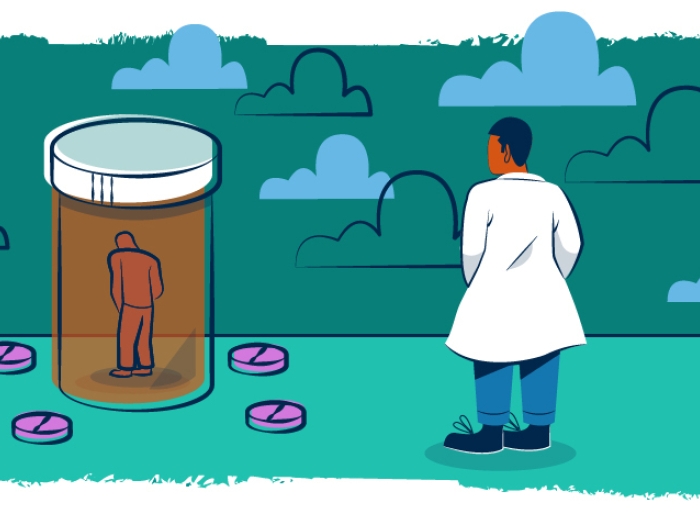Patients’ race, income, family support and disability all play a role in readmission rates, a new study finds. So why don’t Medicare’s hospital penalties consider them?
1:00 PM
Author |

No patient who just got out of the hospital wants to end up there again anytime soon. Nor does the insurance company or agency paying the bill.
MORE FROM THE LAB: Subscribe to our weekly newsletter
That's why, to ease the revolving-door flow, the Medicare system has begun penalizing hospitals with the highest readmission rates for certain conditions.
But a new study suggests that unlike hospital gowns, such penalties should not be one-size-fits-all.
Many elements, after all, are at play, research by a University of Michigan Medical School team finds. Certain social, economic, disability and personal care factors — often present long before a patient enters the hospital — can make a major difference in the readmission risk of people recently hospitalized for heart failure, pneumonia or a heart attack.
Further complicating matters: The negative influence of such factors varies greatly by condition and largely isn't something a hospital can change.
"The relationship between socioeconomic status, functional status and use of health care is not as simple or straightforward as people might think," says Jennifer Meddings, M.D., M.Sc., the first author of the study and an assistant professor of internal medicine at U-M. "The impact is different depending on condition."
In many ways, hospitals these days are being held accountable for the failures of the social safety net.Jennifer Meddings, M.D., M.Sc.
Roadblocks to recovery
Pneumonia patients who already had trouble with multiple tasks like getting dressed or cooking food, or who needed paid help at home, were the most likely of all pneumonia patients to be readmitted in the first 30 days after a hospitalization, the study shows.
SEE ALSO: To Reduce Hysterectomy-Related Readmissions, Target Those at Risk
But for patients with heart failure, that kind of functional difficulty didn't matter as much as their income, family dynamics and race. Those who had a higher wealth level or adult children had a much lower chance of readmission — while black individuals, regardless of salary or offspring, had an increased risk of another hospital stay.
Heart attack survivors, meanwhile, face yet another set of unique criteria. Their most important factors boosting readmission odds: whether they had been in a nursing home before the hospital stay and whether the hospital cared for a high percentage of minority patients.
The study's results, published in the Journal of General Internal Medicine, come from a team from the U-M Medical School and Institute for Healthcare Policy and Innovation and the VA Ann Arbor Healthcare System.
With funding from the Agency for Healthcare Research and Quality, the authors used data from the Health and Retirement Study, based at the U-M Institute for Social Research, and from Medicare. Driving their analysis were four measures of disability and six additional aspects known as social determinants of health.
A model to inform change
Currently, Medicare adjusts its penalties based only on how sick a hospital's patients are; the more severely ill, the lower the penalty.
Which is why the U-M research team started with the existing Medicare adjustments and then added patients' social determinants of health to assess their incremental value.
A resulting model of readmission risk, they say, could be used to predict patients' chances of readmission — and could prompt hospitals to offer extra post-stay support such as transportation and home visits to help patients properly recover.
It also could give the Centers for Medicare and Medicaid Services (CMS), which runs Medicare and pays for the care of tens of millions of seniors and people with serious disabilities, a new tool for determining which hospitals truly have high readmission rates given the diverse complexities of the patients they treat.
Such external factors have been cited in other research as crucial to a patient's overall chance of a good outcome, but they've never been studied for how their impact upon readmission risk may vary among people with the same reason for their initial hospitalization.
Says Meddings: "We hope these findings will inform future adjustments in the models for readmission."
Challenges and potential solutions
Changes to the distribution of Medicare penalties could be on the horizon.
Meddings notes that the CMS has opened the door for socioeconomic status to be considered in its programs. The National Academy of Sciences has convened a committee to evaluate evidence on the topic and present it to the CMS.
SEE ALSO: Should Medicare Hospital Payments Weigh Death and Readmission Equally?
The shift would be significant.
"In many ways, hospitals these days are being held accountable for the failures of the social safety net as policies have been developed and implemented to evaluate the performance of hospitals and tie payment to that," says Meddings. "As these programs are refined, understanding the impact of social determinants of health will be crucial."
Accounting for those determinants that could be helping or hurting a hospital's specific patient population could go two ways, she notes. Factoring in these issues to reduce or increase penalties is one option.
Another would be to provide additional payment for the services for which hospitals aren't typically paid, such as hiring social workers to connect patients with services and external resources that can help them avoid another hospital stay.
Patients who are "dual eligible" — that is, old or disabled enough for Medicare and poor enough for Medicaid — present a special challenge. The study looked at Medicaid status, but the sample size wasn't large enough to determine whether it played a role in readmission risk.
Meddings sees hope for using social determinants of health and disability level in health care payment because many of these measures are now captured in electronic medical records when a person arrives at or is preparing to leave a hospital. The CMS has traditionally used Medicare claims data — how much the hospital billed the system — but mining data could prove fruitful if it can be done uniformly among institutions, Meddings says.
Meanwhile, there is much more work to be done in refining future risk models and the conditions they encompass. Just because a patient has a spouse or an adult child doesn't show how helpful those family members will be, for instance.
Meddings and her colleagues have started studying this same issue in Medicare patients who have had a joint replacement, since the CMS has begun penalizing hospitals for high readmissions after a hip or knee replacement operation.

Explore a variety of healthcare news & stories by visiting the Health Lab home page for more articles.

Department of Communication at Michigan Medicine
Want top health & research news weekly? Sign up for Health Lab’s newsletters today!





